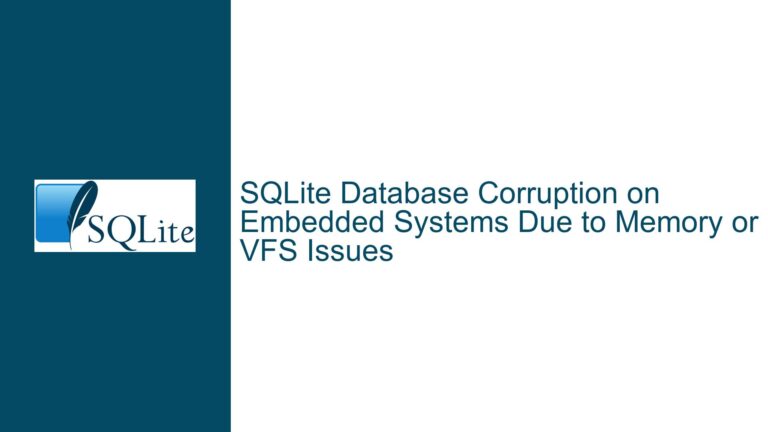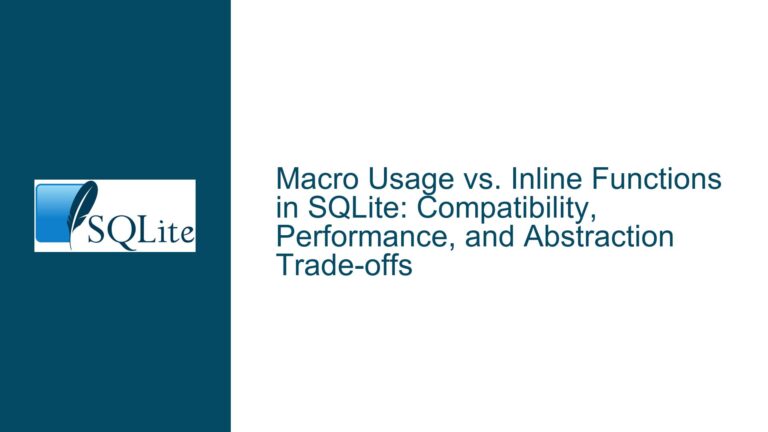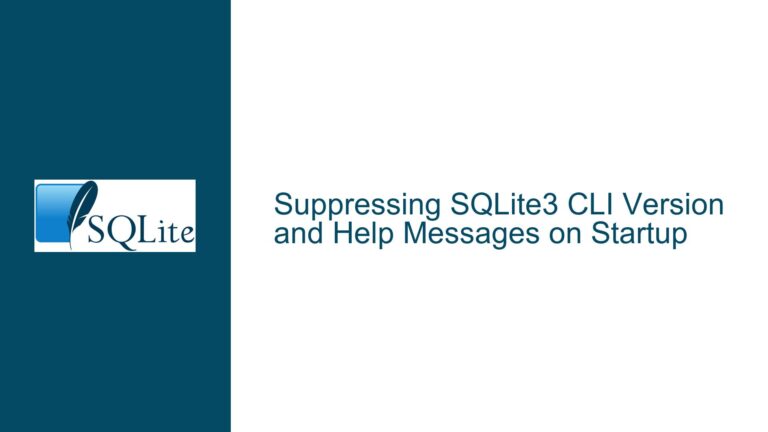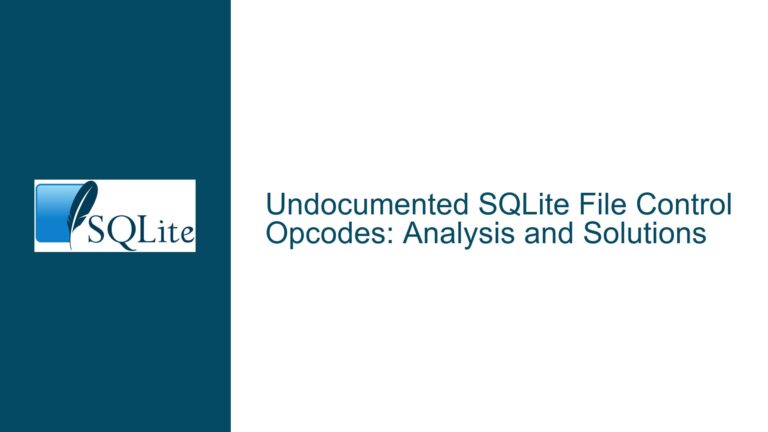and Extending SQLite’s Built-in Operators and Tokenization
Issue Overview: How SQLite Handles Built-in Operators and Tokenization
SQLite is a lightweight, embedded relational database management system that is widely used due to its simplicity, efficiency, and portability. One of the key features of SQLite is its support for built-in operators, such as ->>, MATCH, LIKE, and GLOB, which are essential for querying and manipulating data. These operators are not just syntactic sugar; they are deeply integrated into SQLite’s parsing and execution engine. Understanding how these operators are registered, tokenized, and processed is crucial for anyone looking to extend SQLite’s functionality or debug issues related to query parsing.
The core of the issue revolves around the distinction between built-in operators and user-defined functions in SQLite. Built-in operators are hardcoded into SQLite’s parser and tokenizer, meaning they are part of the SQLite core and cannot be added or removed without modifying the source code. On the other hand, user-defined functions can be added at runtime using the sqlite3_create_function API, but these functions do not have the same level of integration as built-in operators. For example, while you can create a function named BB and call it as BB(1, 2), you cannot use it as an infix operator like 1 BB 2 without modifying SQLite’s parser and tokenizer.
The discussion also touches on the tokenization process, which is the first step in SQLite’s query processing pipeline. Tokenization involves breaking down the input SQL statement into a sequence of tokens, such as keywords, identifiers, literals, and operators. These tokens are then passed to the parser, which constructs a syntax tree based on the grammar defined in parse.y. The tokenizer is responsible for recognizing operators like -> and ->>, as well as keywords like MATCH and LIKE. Understanding this process is essential for anyone looking to add new operators or modify existing ones.
Possible Causes: Why Adding New Operators in SQLite is Non-Trivial
The difficulty in adding new operators to SQLite stems from the way the database engine is designed. SQLite’s parser and tokenizer are tightly coupled, and the set of built-in operators is fixed at compile time. This design choice ensures that SQLite remains lightweight and efficient, but it also means that extending the language with new operators requires modifying the source code and recompiling the entire database engine.
One of the key challenges is that operators in SQLite are not treated as functions. While functions like abs() or upper() can be registered dynamically using the sqlite3_create_function API, operators are part of the SQL grammar and must be recognized by the tokenizer and parsed according to the rules defined in parse.y. For example, the ->> operator, which is used for JSON data extraction, is not a function but a syntactic construct that is hardcoded into the parser. This means that adding a new operator like # would require modifying both the tokenizer (to recognize the new operator) and the parser (to define its syntactic rules and semantics).
Another challenge is that SQLite’s tokenizer is not designed to be extensible at runtime. The tokenizer is responsible for recognizing keywords, identifiers, literals, and operators, and it does so by using a fixed set of rules defined in tokenize.c. While it is possible to modify tokenize.c to recognize new operators, doing so requires a deep understanding of SQLite’s internals and careful testing to ensure that the changes do not introduce regressions or break existing functionality.
Finally, even if you manage to modify the tokenizer and parser to recognize a new operator, you still need to generate the appropriate Virtual Database Engine (VDBE) code to execute the operator. The VDBE is SQLite’s bytecode interpreter, and it is responsible for executing the low-level operations that correspond to SQL statements. Adding a new operator requires not only modifying the parser and tokenizer but also ensuring that the VDBE can handle the new operator correctly. This involves writing new VDBE opcodes and ensuring that they interact correctly with the rest of the SQLite engine.
Troubleshooting Steps, Solutions & Fixes: Extending SQLite’s Operator Set
If you are determined to add a new operator to SQLite, such as #, you will need to follow a series of steps to modify the tokenizer, parser, and VDBE. This process is not for the faint of heart, as it requires a deep understanding of SQLite’s internals and careful testing to ensure that the changes do not introduce regressions or break existing functionality. Below, we outline the steps involved in extending SQLite’s operator set.
Step 1: Modify the Tokenizer to Recognize the New Operator
The first step in adding a new operator is to modify the tokenizer to recognize the new operator. The tokenizer is defined in src/tokenize.c, and it is responsible for breaking down the input SQL statement into a sequence of tokens. To add a new operator, you will need to modify the sqlite3GetToken function, which is responsible for recognizing tokens.
For example, if you want to add the # operator, you will need to add a new case to the sqlite3GetToken function that recognizes the # character as a token. This involves adding a new case to the switch statement that handles single-character tokens. You will also need to define a new token type for the # operator, such as TK_HASH, and ensure that the tokenizer returns this token type when it encounters the # character.
Step 2: Modify the Parser to Define the New Operator’s Syntax and Semantics
Once the tokenizer can recognize the new operator, the next step is to modify the parser to define the new operator’s syntax and semantics. The parser is defined in src/parse.y, and it is responsible for constructing a syntax tree based on the tokens generated by the tokenizer. To add a new operator, you will need to define a new grammar rule in parse.y that specifies how the new operator can be used in SQL statements.
For example, if you want to add the # operator as a binary operator (i.e., an operator that takes two operands), you will need to define a new grammar rule in parse.y that specifies the syntax for the # operator. This might look something like this:
expr(A) ::= expr(B) TK_HASH expr(C). {
// Generate VDBE code for the # operator
// A, B, and C are the operands
}
In this rule, expr(A), expr(B), and expr(C) represent the operands of the # operator, and the action block (enclosed in {}) is where you generate the VDBE code for the operator. You will need to write the appropriate VDBE opcodes to implement the semantics of the # operator.
Step 3: Generate VDBE Code for the New Operator
The final step in adding a new operator is to generate the appropriate VDBE code to execute the operator. The VDBE is SQLite’s bytecode interpreter, and it is responsible for executing the low-level operations that correspond to SQL statements. To add a new operator, you will need to write new VDBE opcodes that implement the semantics of the operator.
For example, if you want to add the # operator as a binary operator that performs a bitwise XOR operation, you will need to write a new VDBE opcode that takes two operands from the stack, performs the XOR operation, and pushes the result back onto the stack. This might look something like this:
case OP_BitwiseXor: {
int a = sqlite3VdbeIntValue(pOp->p1);
int b = sqlite3VdbeIntValue(pOp->p2);
int result = a ^ b;
sqlite3VdbeMemSetInt64(pOut, result);
break;
}
In this example, OP_BitwiseXor is a new VDBE opcode that performs a bitwise XOR operation on two operands. The operands are retrieved from the stack using sqlite3VdbeIntValue, and the result is pushed back onto the stack using sqlite3VdbeMemSetInt64.
Step 4: Test the New Operator Thoroughly
Once you have modified the tokenizer, parser, and VDBE to support the new operator, the final step is to test the new operator thoroughly to ensure that it works correctly and does not introduce any regressions or break existing functionality. This involves writing a series of test cases that exercise the new operator in various contexts, such as in SELECT statements, WHERE clauses, and JOIN conditions.
For example, you might write a test case that uses the # operator in a SELECT statement to perform a bitwise XOR operation on two columns:
SELECT a # b FROM my_table;
You should also test the new operator in combination with other SQLite features, such as transactions, indexes, and triggers, to ensure that it works correctly in all scenarios.
Alternative Approach: Overloading Existing Operators
If modifying SQLite’s source code is not an option, an alternative approach is to overload existing operators to achieve the desired functionality. SQLite allows you to overload the meaning of certain built-in operators, such as LIKE, GLOB, MATCH, REGEXP, ->, and ->>, by defining custom functions that implement the desired behavior.
For example, if you want to add a new operator that performs a bitwise XOR operation, you could overload the ->> operator to perform this operation. This involves defining a custom function that implements the bitwise XOR operation and registering it with SQLite using the sqlite3_create_function API. You can then use the ->> operator in your SQL statements to perform the bitwise XOR operation.
While this approach does not require modifying SQLite’s source code, it has some limitations. First, you are limited to overloading only the operators that SQLite allows you to overload. Second, the syntax for using overloaded operators may not be as intuitive as using a custom operator. For example, using ->> to perform a bitwise XOR operation may be confusing to users who are familiar with the ^ operator in other programming languages.
Conclusion
Adding new operators to SQLite is a complex task that requires a deep understanding of SQLite’s internals and careful testing to ensure that the changes do not introduce regressions or break existing functionality. While it is possible to modify SQLite’s tokenizer, parser, and VDBE to support new operators, this approach is not for the faint of heart and should only be attempted by experienced developers who are familiar with SQLite’s source code.
If modifying SQLite’s source code is not an option, an alternative approach is to overload existing operators to achieve the desired functionality. While this approach has some limitations, it allows you to extend SQLite’s functionality without modifying the source code.
In either case, it is important to thoroughly test any changes to ensure that they work correctly and do not introduce regressions or break existing functionality. By following the steps outlined in this guide, you can extend SQLite’s operator set and add new functionality to the database engine.






